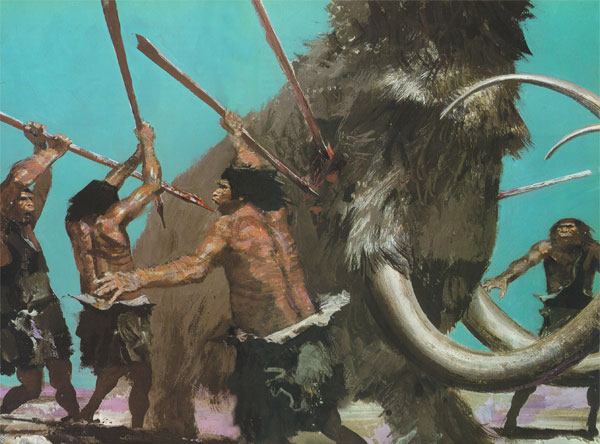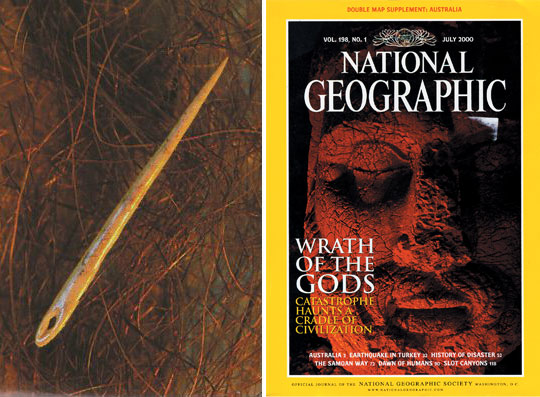3.6-million-year-old human footprints found in Laetoli, Tanzania
3. How Far Back Do Traces Of Man Go? Why Do These Not Support Evolution?
 |
We need to turn to the fossil record to find an answer to the question of when man appeared on Earth. This record shows that man goes back millions of years. These discoveries consist of skeletons and skulls, and the remains of people who lived at various times. One of the oldest traces of man are the "footprints" found by the famous palaentologist Mary Leakey in 1977 in Tanzania's Laetoli region.
These remains caused a great furore in the world of science. Research indicated that these footprints were in a 3.6-million-year-old layer. Russell Tuttle, who saw the footprints, wrote:
A small barefoot Homo sapiens could have made them... In all discernible morphological features, the feet of the individuals that made the trails are indistinguishable from those of modern humans. 9
Impartial examinations of the footprints revealed their real owners. In reality, these footprints consisted of 20 fossilized footprints of a 10-year-old modern human and 27 footprints of an even younger one. Such famous paleoanthropologists as Don Johnson and Tim White, who examined the prints found by Mary Leakey, corroborated that conclusion. White revealed his thoughts by saying:
Make no mistake about it,... They are like modern human footprints. If one were left in the sand of a California beach today, and a four-year old were asked what it was, he would instantly say that somebody had walked there. He wouldn't be able to tell it from a hundred other prints on the beach, nor would you. 10
These footprints sparked an important debate among evolutionists. That was because for them to accept that these were human footprints would mean that the imaginary progression they had drawn up from ape to man could no longer be maintained. However, at this point dogmatic evolutionist logic once again showed its face. Most evolutionist scientists once more abandoned science for the sake of their prejudices. They claimed that the footprints found at Laetoli were those of an ape-like creature. Russell Tuttle, who was one of the evolutionists defending this claim, wrote:
In sum, the 3.5 million-year-old footprint traits at Laetoli site G resemble those of habitually unshod modern humans. None of their features suggest that the Laetoli hominids were less capable bipeds than we are. If the G footprints were not known to be so old, we would readily conclude that there were made by a member of our genus Homo... In any case, we should shelve the loose assumption that the Laetoli footprints were made by Lucy's kind, Australopithecus afarensis. 11
 The remains of a 1.7-million-year-old stone hut |
Another of the oldest remains to do with man was the ruins of a stone hut found in the Olduvai Gorge region by Louis Leakey in the 1970s. The remains of the hut were found in a layer 1.7 million years old. It is known that structures of this kind, of which similar examples are still used in Africa in the present day, could only be built by Homo sapiens, in other words modern man. The significance of the remains is that they reveal that man lived at the same time as the so-called ape-like creatures that evolutionists portray as his ancestors.
A 2.3 million-year-old modern human jaw found in the Hadar region of Ethiopia was very important from the point of view of showing that modern man had existed on the Earth much longer that evolutionists expected.12
One of the oldest and most perfect human fossils is KNM-WT 1500, also known as the "Turkana Child" skeleton. The 1.6 million-year-old fossil is described by the evolutionist Donald Johanson in these terms:
 Turkana Kid |
He was tall and thin, in body shape and limb proportions resembling present-day equatorial Africans. Despite his youth, the boy's limb nearly matched the mean measurements for white North American adult males. 13
It is confirmed that the fossil was that of a 12-year-old boy, who would have been 1.83 metres tall in adolescence. The American paleoanthropologist Alan Walker said that he doubted that "the average pathologist could tell the difference between the fossil skeleton and that of a modern human." Concerning the skull, Walker wrote that he laughed when he saw it because "it looked so much like a Neanderthal."14
One of the human fossils that has attracted the most attention was one found in Spain in 1995. The fossil in question was uncovered in a cave called Gran Dolina in the Atapuerca region of Spain by three Spanish paleoanthropologists from the University of Madrid. The fossil revealed the face of an 11-year-old boy who looked entirely like modern man. Yet, it had been 800,000 years since the child died. This fossil even shook the convictions of Juan Luis Arsuaga Ferreras, who lead the Gran Dolina excavation. Ferreras said:
We expected something big, something large, something inflated–you know, something primitive… Our expectation of an 800,000-year-old boy was something like Turkana Boy. And what we found was a totally modern face.... To me this is most spectacular–these are the kinds of things that shake you. Finding something totally unexpected like that. Not finding fossils; finding fossils is unexpected too, and it's okay. But the most spectacular thing is finding something you thought belonged to the present, in the past. It's like finding something like–like a tape recorder in Gran Dolina. That would be very surprising. We don't expect cassettes and tape recorders in the Lower Pleistocene. Finding a modern face 800,000 years ago–it's the same thing. We were very surprised when we saw it. 15

The Gran Dolina cave in Spain, where the Atapuerca fossil, of a true human being, was found.
As we have seen, fossil discoveries give the lie to the claim of "the evolution of man." This claim is presented by some media organizations as if it were a proven fact, whereas all that actually exist are fictitious theories. In fact, evolutionist scientists accept this, and admit that the claim of "the evolution of man" lacks any scientific evidence.
 In its December 1997 edition, Discover, one of the most popular evolutionist magazines, placed an 800,000-year-old human face on its cover, alongside a headline taken from evolutionists' surprised statement, "Is this the face of our past?" |
For instance, by saying, "We appear suddenly in the fossil record" the evolutionist paleontologists C. A. Villie, E. P. Solomon and P. W. Davis admit that man emerged all of a sudden, in other words with no evolutionary ancestor.16
Mark Collard and Bernard Wood, two evolutionist anthropologists were forced to say, "existing phylogenetic hypotheses about human evolution are unlikely to be reliable." in an article they wrote in 2000. 17
Every new fossil discovery places evolutionists in an even worse quandary, even if certain frivolous newspapers do print headlines such as "Missing link discovered." The fossil skull discovered in 2001 and named Kenyanthropus platyops is the latest example of this. The evolutionist paleontologist Daniel E. Lieberman from Washington University's Department of Anthropology had this to say about Kenyanthropus platyops in an article in the leading scientific journal, Nature:
The evolutionary history of humans is complex and unresolved. It now looks set to be thrown into further confusion by the discovery of another species and genus, dated to 3.5 million years ago… The nature of Kenyanthropus platyops raises all kinds of questions, about human evolution in general and the behaviour of this species in particular. Why, for example, does it have the unusual combination of small cheek teeth and a big flat face with an anteriorly positioned arch of the cheekbone? All other known hominin species with big faces and similarly positioned cheekbones have big teeth. I suspect the chief role of K. platyops in the next few years will be to act as a sort of party spoiler, highlighting the confusion that confronts research into evolutionary relationships among hominins. 18
The latest evidence to shatter the evolutionary theory's claim about the origin of man is the new fossil Sahelanthropus tchadensis unearthed in the Central African country of Chad in the summer of 2002.
The fossil has set the cat among the pigeons in the world of Darwinism. In its article giving news of the discovery, the world-renowned journal Nature admitted that "New-found skull could sink our current ideas about human evolution."19
Daniel Lieberman of Harvard University said that "This [discovery] will have the impact of a small nuclear bomb." 20
The reason for this is that although the fossil in question is 7 million years old, it has a more "human-like" structure (according to the criteria evolutionists have hitherto used) than the 5 million-year-old Australopithecus ape species that is alleged to be "mankind's oldest ancestor." This shows that the evolutionary links established between extinct ape species based on the highly subjective and prejudiced criterion of "human similarity" are totally imaginary.
 1975 PORTRAYAL OF NEANDERTHALS - Geheimnisse der Urzeit, Deutsche Übersetzung, 1975 (left) 2000 PORTRAYAL OF NEANDERTHALS - National Geographic, July 2000 (right) EVOLUTIONISTS' VOLTE-FACE REGARDING THE NEANDERTHALS Since the beginning of the twentieth century, evolutionists have been portraying the Neanderthals, a vanished human race, as semi-ape creatures. The above portrayal of Neanderthals was used as evolutionist propaganda for decades.
However, since the 1980s this myth has begun to collapse. Both fossil studies and traces of Neanderthal culture have shown that these people were not semi-apes.For example, this 26,000-year-old needle proved that Neanderthals were civilised humans who possessed the ability to sew. As a result of this, evolutionist publications such as National Geographic had to start portraying them as civilised, as in the picture below.
2000 portrayal of Neanderthals - National Geographic, July 2000 |
|---|
John Whitfield, in his article "Oldest Member of Human Family Found" published in Nature on July, 11, 2002, confirms this view quoting from Bernard Wood, an evolutionist anthropologist from George Washington University in Washington:
"When I went to medical school in 1963, human evolution looked like a ladder." he [Bernard Wood] says. The ladder stepped from monkey to man through a progression of intermediates, each slightly less ape-like than the last. Now human evolution looks like a bush. We have a menagerie of fossil hominids... How they are related to each other and which, if any of them, are human forebears is still debated.21
The comments of Henry Gee, the senior editor of Nature and a leading paleoanthropologist, about the newly discovered ape fossil are very noteworthy. In his article published in The Guardian, Gee refers to the debate about the fossil and writes:
Whatever the outcome, the skull shows, once and for all, that the old idea of a "missing link" is bunk... It should now be quite plain that the very idea of the missing link, always shaky, is now completely untenable. 22
As we have seen, the increasing number of discoveries is producing results opposed to the theory of evolution, not in favour of it. If such an evolutionary process had happened in the past, there should be many traces of it, and each new discovery should further strengthen the theory. In fact, in The Origin of Species, Darwin claimed that science would develop in just that direction. In his view, the only problem facing his theory in the fossil record was a lack of fossil discoveries. He hoped that future research would unearth countless fossils to support his theory. However, subsequent scientific discoveries have actually proved Darwin's dreams to be totally unfounded.
EVOLUTIONISTS' IMAGINARY HYPOTHESES ARE FAR FROM ACCOUNTING FOR THE ORIGIN OF MAN  Despite 150 years of propagandistic evolutionist research into the origin of man, the fossils discovered show that the first human beings suddenly appeared on the Earth, with no "apelike ancestor." The three different hypotheses on this page illustrate three different and contradictory evolutionist scenarios (Stephen Jay Gould, The Book of Life, 2001). Looking carefully, we can see that there is a question mark in front of Homo erectus, which is shown as the first human race on Earth. The reason for this is that there is no "ape-like" creature that evolutionists can show as being the "ancestor of man." Species in the illustrations, which lack anything linking them to man, are actually extinct species of ape. The origin of man, as we can see, is a mystery for evolutionists, because that origin is not evolution at all, but creation. |
The importance of human-linked remains
The discoveries regarding man, of which we have seen a few examples here, reveal very important truths. In particular, they have once again demonstrated what a great product of fantasy the evolutionists' claim that man's ancestor was an ape-like creature is. For this reason, it is out of the question that these ape species could be man's ancestors.
In conclusion, the fossil record shows us that man came into existence millions of years ago in just the same form as he is now, and that he has come down to the present with absolutely no evolutionary development. If they claim to be genuinely scientific and honest, evolutionists should throw their imaginary progression from ape to man into the bin at this point. The fact that they do not give up this spurious family tree shows that evolution is not a theory that is defended in the name of science, but rather a dogma they are struggling to keep alive in the face of the scientific facts.
Footnotes
9. Ian Anderson, "Who made the Laetoli footprints?” New Scientist, vol. 98, 12 May 1983, p. 373.
10. D. Johanson & M. A. Edey, Lucy: The Beginnings of Humankind, New York: Simon & Schuster, 1981, p. 250
11. R. H. Tuttle, Natural History, March 1990, pp. 61-64
12. D. Johanson, Blake Edgar, From Lucy to Language, p.169
13. D. Johanson, Blake Edgar, From Lucy to Language, p.173
14. Boyce Rensberger, Washington Post, 19 October 1984, p. A11.
15. "Is This The Face of Our Past,” Discover, December 1997, pp. 97-100
16. Villee, Solomon and Davis, Biology, Saunders College Publishing,1985, p. 1053
17. Hominoid Evolution and Climatic Change in Europe, Volume 2, Edited by Louis de Bonis, George D. Koufos, Peter Andrews, Cambridge University Press 2001, chapter 6, (emphasis added)
18. Daniel E. Lieberman, "Another face in our family tree,” Nature, March 22, 2001, (emphasis added)
19. John Whitfield, "Oldest member of human family found,” Nature, 11 July 2002
20. D.L. Parsell, "Skull Fossil From Chad Forces Rethinking of Human Origins," National Geographic News, July 10, 2002
21. John Whitfield, "Oldest member of human family found," Nature, 11 July 2002
22. The Guardian, 11 July 2002
- Introduction
- 2. How does the collapse of the theory of evolution demonstrate the truth of creation?
- 1. Why ıs the theory of evolution not scientifically valid?
- 3. How far back do traces of man go? Why do these not support evolution?
- 4. Why ıs the theory of evolution ''not the basis of biology''?
- 5. Why is the existence of different races not evidence for evolution?
- 6. Why is the claim that human and ape genomes are 99 percent similar and that this confirms evolution not true?
- 7. Why is the claim that dinosaurs evolved ınto birds an unscientific myth?
- 8. What scientific forgery ıs the myth that ''human embryos have gills'' based on?
- 9. Why is ıt deceptive to portray cloning as ''evidence for evolution''?
- 10. Could life have come from outer space?
- 11. Why does the fact that the earth is four billion years old not support the theory of evolution?
- 12. Why are wisdom teeth not evidence of evolution?
- 13. How do the complex structures of the most ancient creatures demolish the theory of evolution?
- 14. Why is denying the theory of evolution portrayed as rejecting development and progress?
- 15. Why is ıt mistaken to think that God could have created living things by evolution?
- 16. Why is it wrong to think that evolution could be confirmed ın the future?
- 17. Why is metamorphosis not evidence of evolution?
- 18. Why is it impossible to account for dna by ''chance''?
- 19. Why is it that bacterial resistance to antibiotics is not an example of evolution?
- 20. What kind of relationship is there between creation and science?


